Greetings, fellow tire enthusiasts! I see you’re here to untangle the mysterious numbers and letters found on the side of your tire.
Let me congratulate you on this journey, for understanding your tire codes is like speaking another language. It might seem like a tricky chore, but it’s an essential part of car maintenance. Let’s buckle up and dig into the exciting world of tires.
What does 106t, 106s, 106q, 106h, 106r, 106v, 106w mean on a tire?
These mysterious tire codes are nothing but an industry-standard language to communicate specific characteristics of your tire. Don’t be alarmed! They’re like nutritional facts on your cereal box, only cooler and rubbery. To clarify, these alphanumeric codes represent the tire’s load index and speed rating.
Let’s say you have a tire marked with 106T. Here, ‘106’ is the load index, and ‘T’ is the speed rating. Now, if we switch to 106H, the load index stays the same, but the speed rating changes. The 106 represents the maximum weight your tire can handle when fully inflated, while the letter indicates the maximum speed at which the tire can carry the load.
Here’s a quick visualization to help you understand better:
| Code | Load Index | Speed Rating |
| 106T | 950 kg | 118 mph |
| 106S | 950 kg | 112 mph |
| 106Q | 950 kg | 100 mph |
| 106H | 950 kg | 130 mph |
| 106R | 950 kg | 106 mph |
| 106V | 950 kg | 149 mph |
| 106W | 950 kg | 168 mph |
Remember, these numbers are not for racing purposes. They’re safety measurements provided by manufacturers to prevent tire failure or blowouts. Always respect the speed limits on the road!
What does 106T mean on a tire?
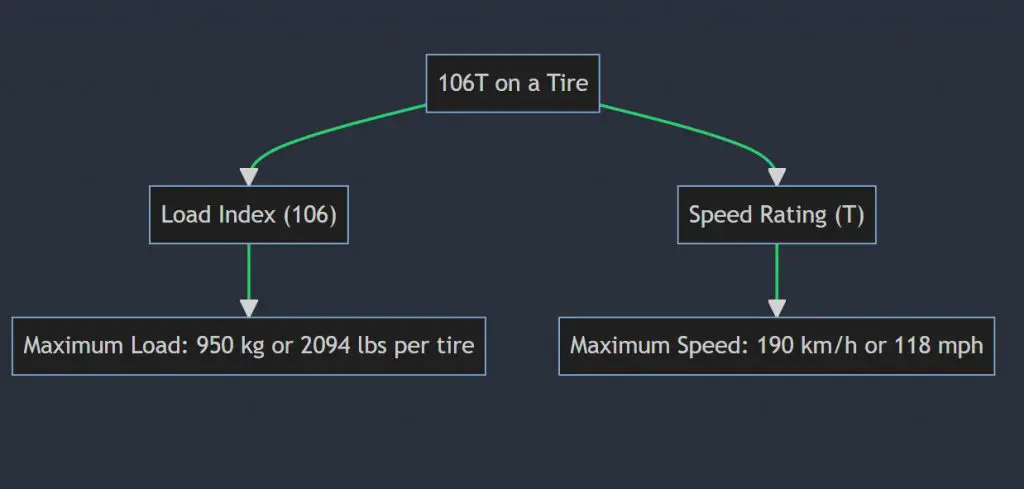
Now that we’ve covered the basics let’s delve into what 106T means on a tire. It’s time to play detective with these alphanumeric tire codes!
Load Index – The 106
‘106’ is the tire’s load index. This three-digit number indicates the maximum weight that the tire can carry when it’s inflated fully. For a load index of 106, this translates to 950 kilograms or 2094 pounds per tire. So, if your vehicle has four 106-rated tires, it can carry a load of up to 3800 kilograms or 8378 pounds. Impressive, isn’t it? It’s like carrying a fully-grown hippopotamus (though I wouldn’t recommend it for the hippo’s sake).
Speed Rating – The T
‘T’ is the tire’s speed rating. Now, you might be thinking, “Does this mean I can channel my inner Vin Diesel?” Not so fast, dear reader. The speed rating ‘T’ signifies the tire can handle speeds up to 118 mph or 190 km/h. But, and this is a BIG but, this doesn’t mean you should test your vehicle at this speed! This rating is simply a measure of how well the tire dissipates heat at higher speeds.
What does 106S mean on a tire?
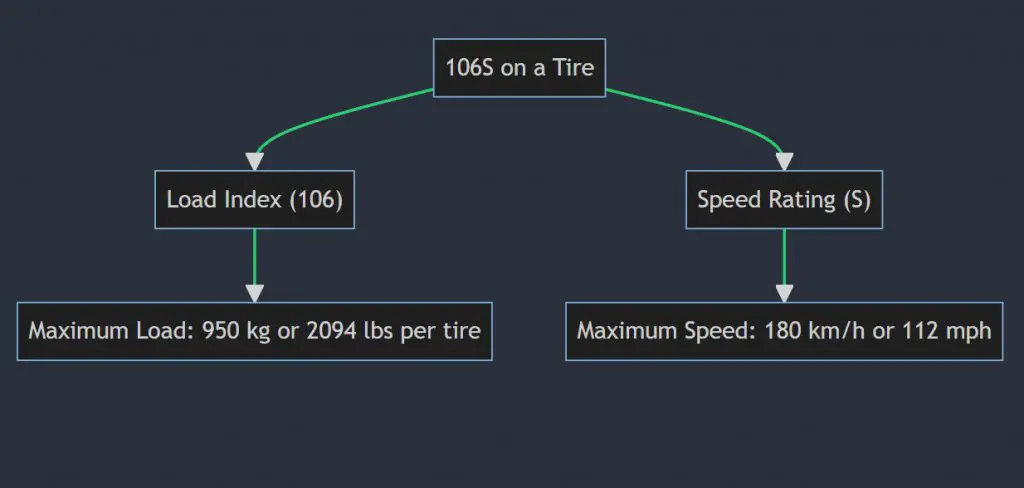
Onwards to the next tire code: 106S. We’ve cracked the 106 code (remember the hippopotamus?), so let’s talk about the ‘S’ speed rating.
Speed Rating – The S
‘S’ as a speed rating on a tire indicates that the tire can handle speeds up to 112 mph or 180 km/h. Much like our earlier discussion, this isn’t an invitation to rev your engine and tear down the highway. It’s merely a safety indication of how well the tire can dissipate heat at that speed without failing.
That’s about the long and short of it, tire comrades! But remember, knowing your tire code is just one part of the wheel story. Regular maintenance, correct pressure, and responsible driving all go hand in hand with your tire’s safety and longevity.
What does 106Q mean on a tire?
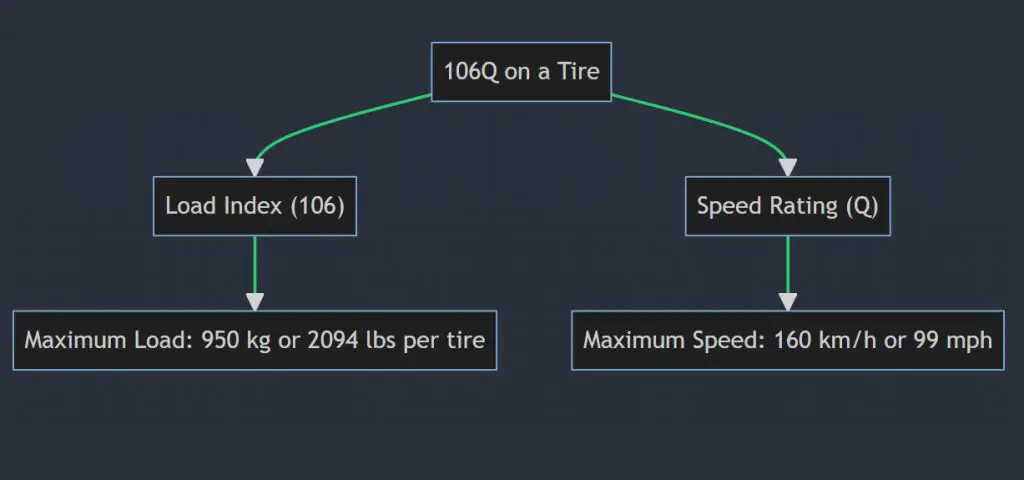
Greetings, tire enthusiasts! Buckle up as we delve deeper into the riveting world of tire codes. We’re about to explore the mystifying and fascinating tire code: 106Q.
The Mystical ‘106’ – Load Index
First things first, let’s decipher the ‘106’. This, my dear readers, is the load index. It might sound like something out of a spy movie, but it’s more straightforward than that. The load index refers to the maximum load that each tire can carry when inflated to its optimum level. For a tire with the load index ‘106’, it can bear a load up to 950 kilograms or 2094 pounds. That’s about as heavy as a small grand piano! Imagine your tire bearing the weight of a Steinway. You wouldn’t need to hire a moving truck next time you want to move your piano for a spontaneous concert!
The Quirky ‘Q’ – Speed Rating
Now, let’s discuss the ‘Q’ part of our tire code. The ‘Q’ represents the tire’s speed rating, the maximum speed at which the tire can safely carry the load. A tire with a ‘Q’ speed rating can carry the maximum load at speeds up to 100 mph or 160 km/h. Now, this doesn’t mean you should try your tire’s speed limit on your way to the grocery store! It’s not a challenge, but a safety measure. It’s merely a parameter to indicate the ability of the tire to dissipate heat at high speeds. Remember, with great speed comes great responsibility!
What does 106H mean on a tire?
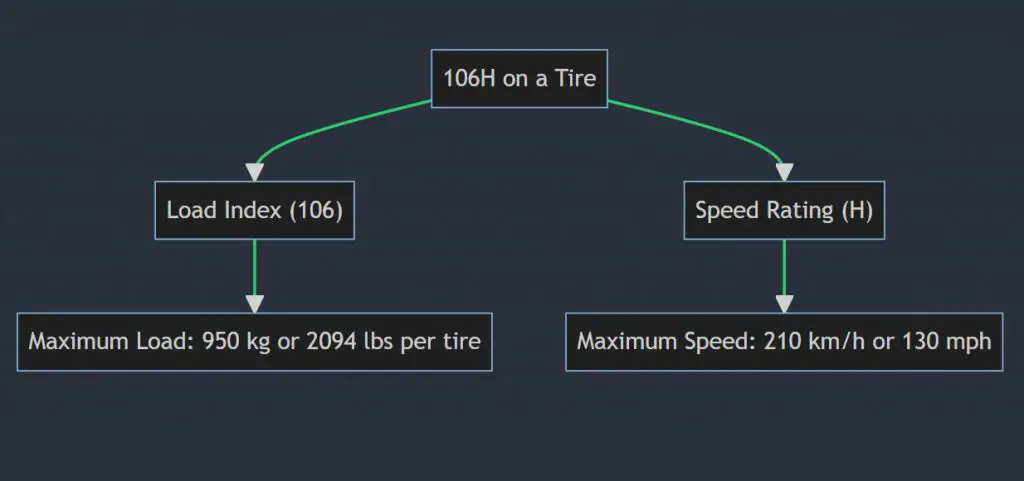
My dear rubber and road enthusiasts, prepare to decrypt another intriguing piece of the tire code puzzle. Let’s unravel the mystery behind 106H!
The Heroic ‘106’ – Load Index
As we’ve established before, ‘106’ is our tire’s load index. This three-digit number tells us that each tire can carry a maximum load of 950 kilograms or 2094 pounds when fully inflated. Now, we know it’s roughly the weight of a small grand piano or even a herd of 14 average-sized sheep, assuming you are, for some bizarre reason, transporting sheep in your car!
The Hardy ‘H’ – Speed Rating
Now let’s crack the ‘H’ in our tire code. ‘H’ indicates the speed rating. A tire with an ‘H’ rating is certified to carry its load at speeds up to 130 mph or 210 km/h. But before you get any wild ideas about turning the freeway into your personal autobahn, remember, this isn’t an invitation for a high-speed race! It’s an assurance that your tire can safely handle and dissipate heat at that speed.
What does 106R mean on a tire?
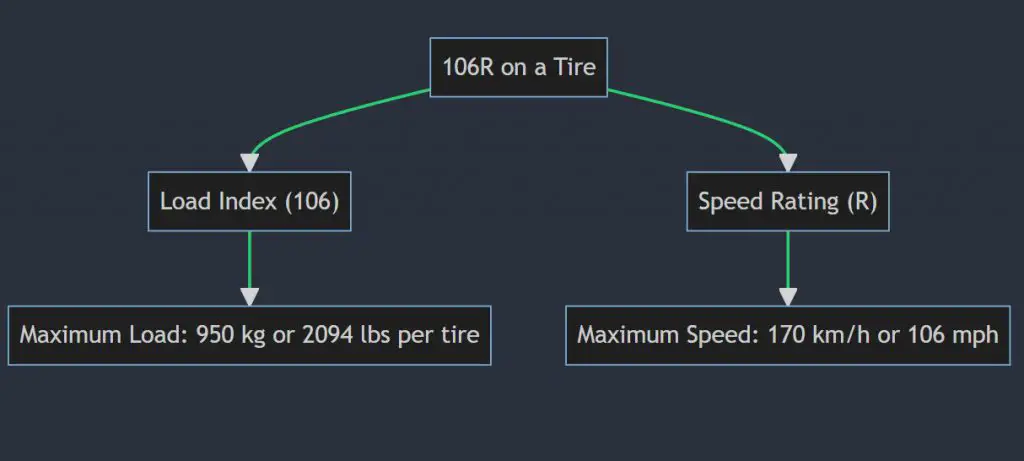
Hello, tire aficionados! Ready to tread further into the riveting world of tire codes? Let’s hit the road and decode the enigmatic 106R!
The Rockstar ‘106’ – Load Index
Again, the ‘106’ here represents the load index of the tire. A load index of ‘106’ means that each tire can carry a maximum load of 950 kilograms, or 2094 pounds when fully inflated. If you’ve been keeping track, you’ll know by now that it’s equivalent to the weight of a grand piano or perhaps a couple of champion-sized pumpkins! Whoever said tire specs weren’t festive?
The Robust ‘R’ – Speed Rating
Here comes the exciting part, the ‘R’! The ‘R’ in our tire code stands for the speed rating. A tire with an ‘R’ rating can sustain its maximum load at speeds up to 106 mph or 170 km/h. However, let me stress this again – these figures aren’t for you to try out on the expressway. They’re there to ensure your tire’s ability to safely dissipate heat at those speeds. So, always respect those speed limits and drive safely!
What does 106V mean on a tire?
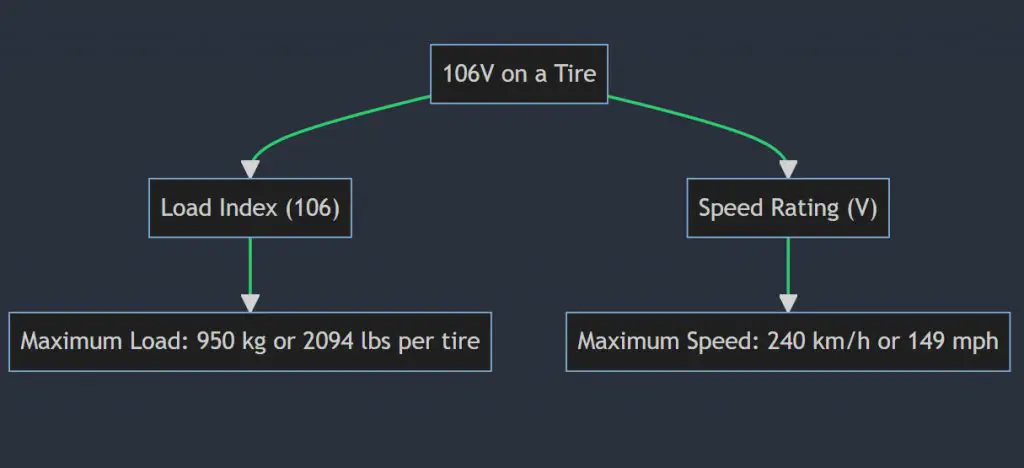
Tire enthusiasts, rev up your engines because we’re going to unveil the mystery behind the 106V tire code!
The Valiant ‘106’ – Load Index
Once again, the ‘106’ is our tire’s load index. Each tire can carry a maximum load of 950 kilograms or 2094 pounds when fully inflated. That’s roughly the weight of an adult male giraffe. However, I can’t stress enough that it’s not advisable to transport a giraffe in your car, no matter how friendly it may seem!
The Vigorous ‘V’ – Speed Rating
Now, onto the ‘V’ in our tire code. It stands for the tire’s speed rating. A tire with a ‘V’ rating can carry its maximum load at speeds up to 149 mph or 240 km/h. Even though it sounds like your tire has been given a license to compete in NASCAR, remember, it’s only a measurement of heat dissipation at those speeds. Safety should always be your first priority when hitting the road.
What does 106W mean on a tire?
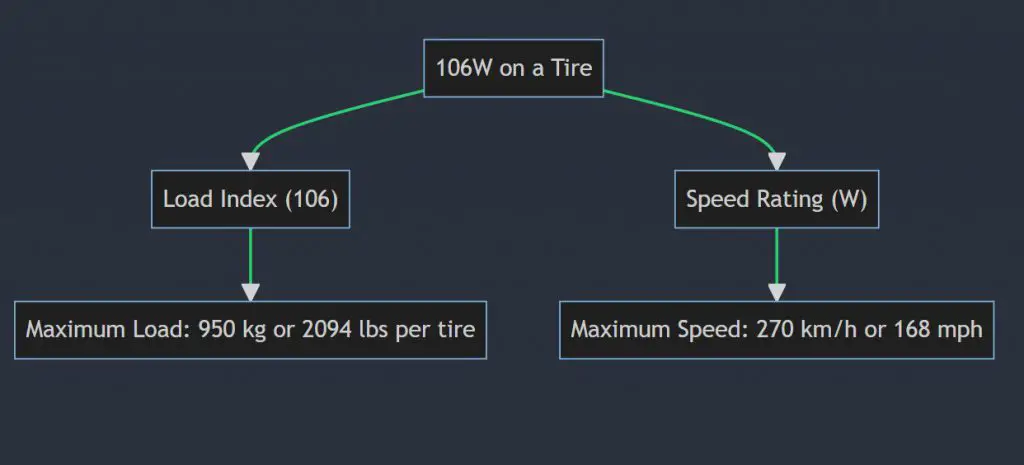
Last but not least, let’s discover the magic behind the 106W tire code!
The Worthy ‘106’ – Load Index
Just like our previous codes, the ‘106’ is the load index. So, each 106W tire can safely carry up to 950 kilograms or 2094 pounds. At this point, you might be wondering how many wheelbarrows of dirt that is. Well, it’s about 63! However, I strongly recommend against testing this.
The Wild ‘W’ – Speed Rating
The ‘W’ here stands for the speed rating. It signifies that your tire can maintain its load at speeds up to 168 mph or 270 km/h. But let’s keep those wild speed fantasies in check! These numbers are for your tire’s safety and longevity. As ever, the name of the game is safe and responsible driving.
Recap And Summary
Alright, rubber-rim-lovers, let’s recap what we’ve learned from our exciting journey through tire codes! We’ve decoded the alphanumeric language of tires from 106T to 106W and unraveled the mystery behind these codes. Whether it’s the load index or the speed rating, we’ve seen that every digit and letter play a pivotal role in ensuring your safety on the road.
Remember, the ‘106’ in the tire code stands for the load index, which tells us each tire can carry a maximum load of 950 kilograms or 2094 pounds. And the letters from ‘T’ to ‘W’ signify the tire’s speed rating – the maximum speed at which the tire can carry its load safely.
FAQs
What does 106Y XL mean on a tire?
106Y XL on a tire indicates the load index and speed rating of the tire, similar to our earlier discussions. ‘106’ is the load index, while ‘Y’ signifies that the tire can sustain speeds up to 186 mph or 300 km/h. The ‘XL’ stands for ‘Extra Load’, meaning the tire can carry a heavier load at a higher inflation pressure compared to standard tires.
106T vs 106H
The difference between 106T and 106H lies in their speed ratings. While both can carry the same load (2094 lbs or 950 kg), a 106T-rated tire can sustain speeds up to 118 mph, while a 106H-rated tire can handle speeds up to 130 mph.
106T vs 106V
Again, the difference here is the speed rating. A 106T-rated tire can handle speeds up to 118 mph, while a 106V-rated tire can manage speeds up to 149 mph.
104S vs 106T
In this comparison, both the load index and speed rating differ. A 104S tire can carry up to 900 kg or 1984 lbs at a maximum speed of 112 mph. However, a 106T tire can carry a higher load (950 kg or 2094 lbs) and sustain slightly higher speeds of 118 mph.
104T vs 106T
Here, only the load index differs. The 104T tire can carry up to 900 kg or 1984 lbs, while the 106T can handle a slightly higher load of 950 kg or 2094 lbs. Both can sustain speeds up to 118 mph.
102T vs 106T
This comparison is also about the load index. A 102T tire can carry up to 850 kg or 1874 lbs, while a 106T tire can handle more weight, up to 950 kg or 2094 lbs. The speed both can sustain is 118 mph.
Final Verdict
Cracking the tire code is a bit like learning a new language. It may seem overwhelming at first, but once you get the hang of it, you’ll be deciphering those mysterious markings with ease.
And remember, the tire codes are there for your safety, not to test your vehicle’s limits. Always obey speed limits and carry loads within your vehicle’s capacity. These codes are simply a way for manufacturers to communicate the tire’s capabilities. So, let’s pledge to use this newfound knowledge wisely and responsibly.
Drive safe, folks, and may the road always rise up to meet your well-coded tires!
Alternative Tire Size Codes of Similar Specifications

AR Jeet has been a tire mechanic for over 2years. He has worked on all types of vehicles, from cars and trucks to RVs and ATVs and motorcycles. He has seen it all when it comes to tires, and he knows how to fix them.
AR Jeet is a tire expert, and he is passionate about his work. He loves to help people keep their vehicles running smoothly, and he is always happy to answer any questions that people have about their tires.
If you need help with your tires, or if you just want to learn more about them, then AR Jeet is the man to talk to. He will be happy to help you out, and he will make sure that you get the best possible solution.
He has a blog [Tirespick.com] where he writes about all things tire-related, and he is always happy to help people with their tire needs. Know more about AR Jeet.

